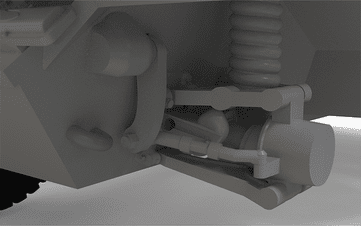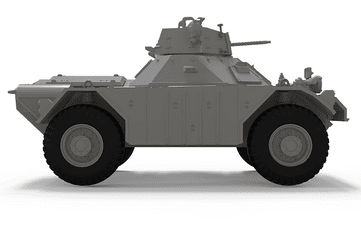Weighing in at just over four tons when at operational weight, the Ferret was of all welded construction and featured armour protection capable of withstanding most small arms fire, but nothing much heavier than that, as it was never intended that the vehicle would be operating in direct opposition to heavy enemy armour. If it did find itself in a contact situation, the 4 wheel drive Ferret was powered by a reliable 4.2 litre 6 cylinder Rolls Royce in-line engine, which gave the vehicle a top speed of between 45 and 50 mph using a 5 speed pre-selector gearbox. Impressively, this unit allowed the Ferret to achieve these speeds in reverse should the situation require, something which might prove extremely useful if the crew found themselves in a tight spot when reconnoitring enemy positions.
The distinctively large ‘Run Flat’ tyres were actually quite an important feature of the vehicle and very much added to the survivability and operability of this extremely useful vehicle. Designed to remain inflated and fully serviceable despite sustaining quite significant damage, they were intended to allow the Ferret and its crew to get back to base, even when one or all of them had been damaged. For that reason, it’s sometimes a little baffling to note that many Ferrets also carried a spare tyre, even though it was highly unlikely that it would either be needed, or indeed safe to change in a contact situation – it must have been quite heavy too. What makes this all the more surprising is the fact that fitting the spare wheel to the hull of the vehicle actually blocked one of the crew emergency escape hatches, placing even more emphasis on its ability to use speed and stealth to extricate itself from a contact situation.
These impressive tyres certainly helped to make the Ferret the overwhelming success that it was, allowing the vehicle to operate over virtually any terrain, something which must have been a prominent feature of the Ferret’s initial design brief. With military operations being as much about towns and cities as it is open countryside, the high speed performance of the Ferret could be brought to bear in a wide variety of operational situations, something which would ensure its service longevity. Just as much at home patrolling the streets of Belfast as it was looking for enemy positions from a concealed hedgerow position, the Ferret could be used on traditional roads just like a normal car/truck, where heavier tracked vehicles would undoubtedly cause damage to such surfaces.
3Scheme Options
Scheme A – FV 701(C) Ferret Armoured Car, West Germany, August 1961.


Scheme B – FV 701(C) Ferret Armoured Car, British Army Training Unit Suffield (BATUS), Canadian Forces Base Suffield, Alberta, Canada, 1980s.


Scheme C – FV 701(C) Ferret Armoured Car, 5th Parachute Brigade, British Army Overseas, Cyprus, 1974.


A computer rendered image taken from the Ferret design files produced

Although this colourful design image has been shown on in a Workbench blog previously, it definitely helps to increase the excitement levels as we prepare for the first release from this spectacular new tooling project.

Small but perfectly formed, the new Ferret Scout Car is packed full of detail and is a really interesting subject – modellers are going to love it!

This stunning new artwork features a Ferret which served with the British Army in Berlin during the historic erection of the Berlin Wall.

After a series of successful light armoured reconnaissance and liaison vehicles, the Ferret Scout Car saw widespread military service from the 1950s right up to the Gulf War in 1990. The Ferret was designed with stealth in mind, able to probe enemy positions. This four-wheel drive vehicle was powered by a reliable 6-cylinder Rolls Royce engine which proved extremely useful if the crew found themselves in a tight spot.

A future release of note, many people are very much looking forward to getting their hands on one of our new 1/35th scale Ferret Scout Car kits.
Expected Summer 2023










































You must be logged in to post a comment.